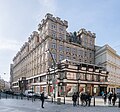Pavel Janák
Pavel Janák (born March 12, 1882 in Prague ; † April 1, 1956 there ) was a Czech architect .
Life
From 1899 to 1908 Pavel Janák studied at the Czech University in Prague, where he also attended Josef Zítek's classes at the German Technical Center. In 1906 he went to Vienna to complete his studies with Otto Wagner at the Academy of Fine Arts. During this time there was also initial contact with the works of the architects Josef Hoffmann and Adolf Loos . After Janák returned to Prague, he worked in Jan Kotěra's office and, as a member of the Mánes artists 'association, also helped found the Artěl artists' association. There he worked together with a group of artisans and architects such as Josef Gočár , Vlastislav Hofmann and Josef Chochol to develop a stylistic canon of Czech Cubism forms for handicrafts and architecture. References to the Bohemian Baroque as well as Gothic buildings flowed into the design language. When various members of the Mánes Artists' Association left in 1911, Pavel Janák followed suit and the “Group of Visual Artists” (Skupina výtvarných umelcu) was founded. In 1912, Pavel Janák, along with Gocár and Hofmann, was one of the founders of the “Prague Art Workshop” (PUD), which was founded to expand the design of practical art from ceramics, glass and metal to Cubist furniture production. He was also involved in the establishment of the Czech Werkbund in 1914, of which he was to take over the chairmanship 10 years later. In 1913 he and a number of other Czech artists were invited by Herwarth Walden to the First German Autumn Salon in Berlin, where he showed two pen drawings and a pastel drawing with the design of the renovation of Deutsch Brod's town hall .
After the First World War (1918) Janák developed together with Gocár - out of an effort for national identity in the Czechoslovak Republic - the " national style ". An important work from this period is the Adria Palace (1922–1924) in Prague. In 1921 Pavel Janák was appointed to the Prague School of Applied Arts, where he taught as a professor until 1942. As chairman of the Czech Werkbund in 1928, he took over the framework planning and the planning of some buildings in the Baba model house development . From the mid-1930s Janák turned more and more to the tasks of monument protection, culminating in his appointment as the main architect of Prague Castle . Through his commitment in this area, he shaped the handling of historical buildings in the still new Czechoslovak Republic.
Projects
- Hlávka Bridge, Prague-Karlín; 1908-1912
- Competition for the completion of the Old Town Hall , Prague Old Town; 1909 (project)
- Jakubec House, Jičín; 1911-1912
- Redesign of the south side of the Pelhřimov market square ; 1912
- Drechsel House, Pelhřimov; 1912
- Renovation of the town hall in Nemecký Brod, Havlíčkův Brod; 1912–1913 (project)
- Competition for the erection of the Žižka monument, Prague- Žižkov ; 1913 (project)
- Water weir with keeper's house, Předměřice nad Labem ; 1913–1915 (destroyed in the flood in 1929)
- Row house settlement “Colony of State Employees”, Prague-Strašnice; 1919-1921
- Café Julis, Prague New Town; 1920–1921 (destroyed)
- Villa Dr. Picka, Jaroměř ; 1920-1921
- Crematorium , Pardubice ; 1921-1923
- Villa Horovský, Prague-Hodkovicky; 1921-1922
- Adria Palace, Prague New Town; 1922-1925
- Studio houses, Prague-Ořechovka; 1923-1924
- Agricultural Museum, Pressburg ; 1924-1925
- Hotel Julis, Prague New Town; 1927-1930
- Framework planning for the model house settlement Baba ; 1928-1934
- Villa Janák (1931–1932), Dovolil (1932), Lindová (1933–1934) (Werkbundsiedlung Baba)
- Reconstruction and extension of the Czernin Palace , Prague- Hradschinvorstadt ; 1928-1936
- Reconstruction and renovation of the riding school, Prague-Hradschinvorstadt; 1945
- Renovation of the Great Ballroom, Prague-Hradschinvorstadt; 1946
- Reconstruction of the pleasure palace Hvězda , Prague-Horní Liboc; 1949-1951
- Refurbishment and renewal of the Royal Pleasure Palace , Prague-Hradschinvorstadt; 1953-1955
literature
- Pavel Janák: Starobylý ráz krásného náméstí v Pelhrimové ohrozen novostavbou hotelu. In: Za starou Prahu. Vol. 3, 1912, ZDB -ID 801257-x , pp. 33-35.
- Marie Beneśová: Pavel Janák (= Nové prameny. Vol. 25, ZDB -ID 412579-4 ). Nakladatelstvi Ceskoslovenských Výtvarných Umelcu, Prague 1959.
- Norbert Kiesling: Pavel Janák . Verlag Bibliothek der Provinz , Weitra 2012. ISBN 978-3-99028-016-4 .
Web links
- Literature by and about Pavel Janák in the catalog of the German National Library
- Literature and other media by and about Pavel Janák in the catalog of the National Library of the Czech Republic
- Pavel Janák. In: arch INFORM .
- Homepage of Pavel Janák (Czech)
| personal data | |
|---|---|
| SURNAME | Janák, Pavel |
| BRIEF DESCRIPTION | Czech architect and architectural theorist |
| DATE OF BIRTH | March 12, 1882 |
| PLACE OF BIRTH | Prague |
| DATE OF DEATH | April 1, 1956 |
| Place of death | Prague |



